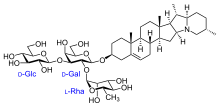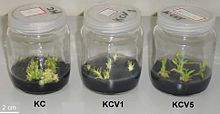Secondary metabolite
This article needs additional citations for verification. (December 2008) |


Secondary metabolites, also called specialised
The term secondary metabolite was first coined by
Secondary metabolites commonly mediate antagonistic interactions, such as
Plant secondary metabolites
Plants are capable of producing and synthesizing diverse groups of organic compounds and are divided into two major groups: primary and secondary metabolites.
Chemical classes
Terpenoids


| Number of isoprene units | Name | Carbon atoms |
|---|---|---|
| 1 | Hemiterpene | C5 |
| 2 | Monoterpene | C10 |
| 3 | Sesquiterpenes | C15 |
| 4 | Diterpene | C20 |
| 5 | Sesterterpene | C25 |
| 6 | Triterpene | C30 |
| 7 | Sesquarterterpene | C35 |
| 8 | Tetraterpene | C40 |
| More than 8 | Polyterpene |
Examples of
- Neemtree)
- Artemisinin, present in Artemisia annua, Chinese wormwood
- Tetrahydrocannabinol, present in Cannabis sativa, cannabis
- Chenopodium quinoa, quinoa.
Phenolic compounds
Phenolics are a chemical compound characterized by the presence of aromatic ring structure bearing one or more hydroxyl groups. Phenolics are the most abundant secondary metabolites of plants ranging from simple molecules such as phenolic acid to highly polymerized substances such as tannins. Classes of phenolics have been characterized on the basis of their basic skeleton.
| No. of carbon atoms | Basic skeleton | Class |
|---|---|---|
| 6 | C6 | Simple phenols |
| 7 | C6 - C1 | Phenolic acids |
| 8 | C6 - C2 | Acetophenone, Phenyle acetic acid |
| 9 | C6 - C3 | Phenylepropanoids, hydroxycinnamic acid, coumarins |
| 10 | C6 - C4 | Naphthoquinone |
| 13 | C6 - C1- C6 | Xanthone |
| 14 | C6 - C2 - C6 | Stilbene, anthraquinone |
| 15 | C6 - C3 - C6 | Flavonoids, isoflavanoids |
| 18 | (C6 - C3 ) 2 | lignans, neolignans |
| 30 | ( C6 - C3 - C6)2 | Biflavonoids |
An example of a plant phenol is:
- Resveratrol, a C14 stilbenoid produced by e.g. grapes.
Alkaloids

Alkaloids are a diverse group of nitrogen-containing basic compounds. They are typically derived from plant sources and contain one or more nitrogen atoms. Chemically they are very heterogeneous. Based on chemical structures, they may be classified into two broad categories:
- Non heterocyclic or atypical alkaloids, for example taxol
- Heterocyclic or typical alkaloids, for example quinine, caffeine, and nicotine
Examples of alkaloids produced by plants are:
- Hyoscyamine, present in Datura stramonium
- deadly nightshade
- Cocaine, present in Erythroxylum coca the Coca plant
- Scopolamine, present in the Solanaceae (nightshade) plant family
- opium poppy
- rosy periwinkle
Many alkaloids affect the central nervous system of animals by binding to neurotransmitter receptors.
Glucosinolates

Glucosinolates are secondary metabolites that include both sulfur and nitrogen atoms, and are derived from glucose, an amino acid and sulfate.
An example of a glucosinolate in plants is Glucoraphanin, from broccoli (Brassica oleracea var. italica).
Plant secondary metabolites in medicine
Many drugs used in modern medicine are derived from plant secondary metabolites.

The two most commonly known

Codeine, also an alkaloid derived from the opium poppy, is considered the most widely used drug in the world according to World Health Organization. It was first isolated in 1832 by a French chemist Pierre Jean Robiquet, also known for the discovery of caffeine and a widely used red dye alizarin.[21] Primarily codeine is used to treat mild pain and relief coughing[22] although in some cases it is used to treat diarrhea and some forms of irritable bowel syndrome.[22] Codeine has the strength of 0.1-0.15 compared to morphine ingested orally,[23] hence it is much safer to use. Although codeine can be extracted from the opium poppy, the process is not feasible economically due to the low abundance of pure codeine in the plant. A chemical process of methylation of the much more abundant morphine is the main method of production.[24]
Digoxin is a cardiac glycoside first derived by William Withering in 1785 from the foxglove (Digitalis) plant. It is typically used to treat heart conditions such as atrial fibrillation, atrial flutter or heart failure.[30] Digoxin can, however, have side effects such as nausea, bradycardia, diarrhea or even life-threatening arrhythmia.
Fungal secondary metabolites
The three main classes of fungal secondary metabolites are:
Examples of other fungal secondary metabolites are:
- oyster mushrooms.
- Aflatoxin B1, a polyketide from Aspergillus flavus.
- Ciclosporin, a non-ribosomal cyclic peptide from Tolypocladium inflatum.
Fungal secondary metabolites can also be dangerous to humans.
Bacterial secondary metabolites
Bacterial production of secondary metabolites starts in the
An example of a bacterial secondary metabolite with a positive and negative effect on humans is botulinum toxin synthesised by Clostridium botulinum. This exotoxin often builds up in incorrectly canned foods and when ingested blocks cholinergic neurotransmission leading to muscle paralysis or death. However, botulinum toxin also has multiple medical uses such as treatment of muscle spasticity, migraine and cosmetics use.
Examples of other bacterial secondary metabolites are:
Phenazine
- Pyocyanin, from Pseudomonas aeruginosa.
- Other phenazines from Pseudomonas ssp. and Streptomyces ssp.
Polyketides
- Avermectin, from Streptomyces avermitilis.
- myxobacterium Sorangium cellulosum.
- Erythromycin, Saccharopolyspora erythraea.
- Nystatin, from Streptomyces noursei.
- Rifamycin, from Amycolatopsis rifamycinica.
Nonribosomal peptides
- Bacitracin, from Bacillus subtilis (Tracy strain).
- Gramicidin, from Brevibacillus brevis.
- Polymyxin, from Paenibacillus polymyxa.
- Ramoplanin, from Actinoplanes strain ATCC 33076.
- Teicoplanins, from Actinoplanes teicomyceticus.
- Vancomycin, from the soil bacterium Amycolatopsis orientalis.
Ribosomal peptides
- Microcins, bacteriocins such as microcin V from Escherichia coli.
- Thiostrepton, from several strains of streptomycetes, e.g. Streptomyces azureus.
Glucosides
- Nojirimycin, an iminosugar from a class of Streptomyces species.
Alkaloids
- pufferfish.
Biotechnological approaches

Selective breeding was used as one of the first biotechnological techniques used to reduce the unwanted secondary metabolites in food, such as naringin causing bitterness in grapefruit.[38] In some cases increasing the content of secondary metabolites in a plant is the desired outcome. Traditionally this was done using in-vitro plant tissue culture techniques which allow for: control of growth conditions, mitigate seasonality of plants or protect them from parasites and harmful-microbes.[citation needed] Synthesis of secondary metabolites can be further enhanced by introducing elicitors into a tissue plant culture, such as jasmonic acid, UV-B or ozone. These compounds induce stress onto a plant leading to increased production of secondary metabolites.
To further increase the yield of SMs new approaches have been developed. A novel approach used by Evolva uses recombinant yeast S. cerevisiae strains to produce secondary metabolites normally found in plants. The first successful chemical compound synthesised with Evolva was vanillin, widely used in the food beverage industry as flavouring. The process involves inserting the desired secondary metabolite gene into an artificial chromosome in the recombinant yeast leading to synthesis of vanillin. Currently Evolva produces a wide array of chemicals such as stevia, resveratrol or nootkatone.
Nagoya protocol
With the development of recombinant technologies the Nagoya Protocol on Access to Genetic Resources and the Fair and Equitable Sharing of Benefits Arising from their Utilization to the Convention on Biological Diversity was signed in 2010. The protocol regulates the conservation and protection of genetic resources to prevent the exploitation of smaller and poorer countries. If genetic, protein or small molecule resources sourced from biodiverse countries become profitable a compensation scheme was put in place for the countries of origin.[39]
See also
- Chemical ecology
- Hairy root culture, a strategy used in plant tissue culture to produce commercially viable quantities of valuable secondary metabolites
- Plant physiology
- Volatile Organic Compounds
- Cetoniacytone A
References
- PMID 23221596.
- ^ "Secondary metabolites - Knowledge Encyclopedia". www.biologyreference.com. Retrieved 2016-05-10.
- PMID 13103145.
- .
- PMID 11044721.
- PMID 19178566.
- ^ S2CID 18888324.
- ^ ISBN 978-1-118-10117-9.
- ISBN 9781461549130.
- .
- OCLC 857764171.
- doi:10.3381/18-063.
- PMID 20303821.
- ^ "Paclitaxel Monograph for Professionals". Drugs.com. Retrieved 2020-04-04.
- ^ "Success Story: Taxol". dtp.cancer.gov. Retrieved 2020-04-04.
- PMID 20202949.
- ^ PMID 19032534.
- PMID 1755865.
- PMID 24940131.
- ^ "Poppy for Medicine". 2007-09-28. Archived from the original on 2007-09-28. Retrieved 2020-04-11.
- ISSN 0187-893X.
- ^ a b "Codeine Monograph for Professionals". Drugs.com. Retrieved 2020-04-05.
- ^ "Equianalgesic", Wikipedia, 2020-04-02, retrieved 2020-04-05
- ^ "UNODC - Bulletin on Narcotics - 1958 Issue 3 - 005". United Nations : Office on Drugs and Crime. Retrieved 2020-04-05.
- ^ "Atropine Side Effects Center".
- ^ "Resveratrol: MedlinePlus Supplements". medlineplus.gov. Retrieved 2020-04-07.
- PMID 21698226.
- PMID 16323269.
- PMID 28620474.
- ^ "Digoxin Monograph for Professionals". Drugs.com. Retrieved 2020-04-07.
- PMID 28632991.
- ^ Conniff R (2017-07-03). "Penicillin: Wonder Drug of World War II". HistoryNe t. Retrieved 2020-04-11.
- PMID 7614366.
- PMID 17302963.
- PMID 23587710.
- S2CID 54245612.
- ISBN 978-0-12-384733-1. Retrieved 2020-04-10.
- PMID 11101467.
- ^ Biosafety Unit (2020-04-14). "The Nagoya Protocol on Access and Benefit-sharing". www.cbd.int. Retrieved 2020-04-15.
External links
 Media related to Secondary metabolites at Wikimedia Commons
Media related to Secondary metabolites at Wikimedia Commons
